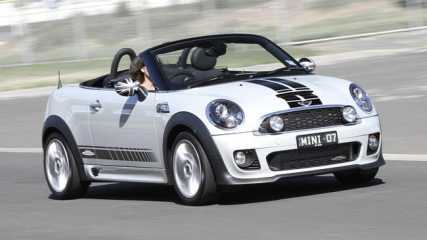Mini Coupe and Roadster 2012 review: road test
By Mark Hinchliffe · 02 Mar 2012
The mini range of Minis is becoming a maxi range with the addition of its first two-seaters. When the new Mini was launched 10 years ago, it arrived as a hatch, followed shortly by a soft-top and that was it for body styles for several years.About 15 months ago a five-door Clubman wagon was added and last year a jacked-up, all-wheel-drive version, the Countryman, arrived. Now Mini has added a two-seater Coupe and Roadster with a Paceman (coupe version of the Countryman) coming next year and possibly a Clubvan (solid-sided Clubman) which is yet to be evaluated for Australia.Prices start at $42,990 for the six-speed manual Cooper S Coupe and $52,600 for the John Cooper Works Coupe. While the convertible version of the Hatch costs a premium of more than $8000, the rag-top variant of the Coupe is only an extra $2010 for the Cooper S and $2500 for the JCW making the Roadster an attractive option. Six-speed auto adds $2350 to the price, which is the same across the Mini fleet. The JCW only comes in manual. Mini Australia boss Kai Bruesewitz believes the new two-seater competes in a narrow class of vehicles with a wide range of prices, from the Honda CR-Z (from $34,990) to the Audi TT (from $70,400). Other competitors are the Peugeot RCZ (from $54,990), VW Eos ($49,990) and Mazda MX-5 (soft top $44,265, coupe $47,200). While this is unchartered territory for Mini, they believe about two-thirds of buyers will opt for the Coupe and about 10 per cent will want the JCW which is one of the highest rates in the world, says Bruesewitz.Given its sporty body shape, it makes sense that the Coupe and Roadster only arrive n Cooper S and JCW variants. The Cooper S comes with the turbo 1.6-litre with 135kW of power and a thirst of 6.3 litre per 100km, while the JCW has 155kW and 7.1L/100km. The chassis in both Coupe and Roadster are based on the stiffer and heavier Cabrio. While the Coupe weighs 1165kg which is a surprising 15kg more than the Hatch despite its lack of back seat and roof, the Roadster weighs an extra 20kg than the Coupe but is a surprisingly 45kg lighter than the Cabrio. Engineers have stiffened the springs on Coupe and Roadster and there is an even stiffer sports suspension available in the Cooper S to match the JCW. All the usual tech features of the Mini are available, but a glaring omission in a market obsessed with with phones is Bluetooth audio streaming. This is what the new variants are all about. They are a design exercise, with few technological changes from the Hatch and Cabrio. Designers specifically intended for the strange Coupe roof line to look like a backwards-facing baseball cap. It looks ridiculous from the side view, but works from the front and rear. The overhanging lip or cap peak also has a practical use, acting as a roof spoiler. There is also an auto boot spoiler on both models which deploys at 80km/h and retracts at 60km/h with a switch inside to manually deploy. Roadster has more appeal from all angles, accentuating Mini's first three-box silhouette. Apart from the obvious roofline, the new models feature a 13 per cent greater raked windscreen. Dimensions are roughly the same as the Hatch, but it sits slightly lower. Inside is standard Mini fare, although the rear seat is gone and there is a small storage area for a couple of shopping bags or briefcase. The big surprise is the cargo area which has more room than the Hatch, while the soft top, which can be manually deployed in about half the time of electric roofs, does not steal precious boot space. The boot is also wide for easy luggage access.The Coupe's roof has been scalloped out so this will suit the tallest of drivers. Product and pricing manager Sue McCarthy says the usual interminable array of Mini options and accessories are available for customisation.There are four airbags and all the usual passive and active safety features of the other Mini models. While they have not yet been crash tested here or in Europe, the Mini Cooper has a maximum five-star rating. Roadster gets two permanent but stylish chromed rollover bars. Rear vision in the Coupe is scant and worse in the Roadster. The boot spoiler only makes matters worse.As expected, it handles like a go-kart, torque-steers like a banshee and the suspension crashes through harsh surfaces. However, the suspension adjustments for the heavier chassis have livened up the steering so there is less understeer and even sharper turn-in. On the down side, ride is further compromised and the car tended to skip sideways over high-speed bumps such as corrugations in corners.On the national launch through the Yarra Valley, both cars were an exciting drive, but after a couple of hours of hitting the bump stops over some of the more gnarly sections of road, my neck and head began to ache. It also didn't help that the cabin is quite noisy, probably because of the lack of sound dampening with the absent rear seat. We also found the flimsy parcel shelf developed an annoying rattle and the rag top vibrated against the metal ribs. Mini's famous "look at me" value is increased, especially in the radical Coupe. People stop, stare, point, but mostly smile and wave.

